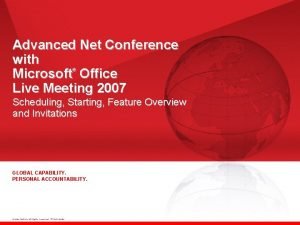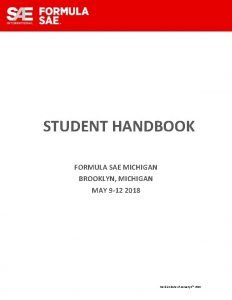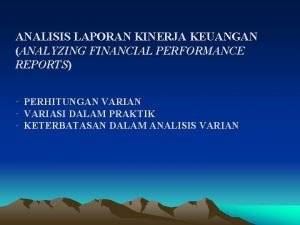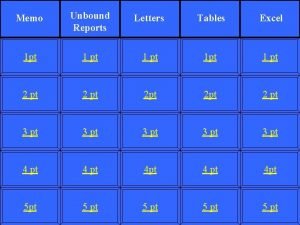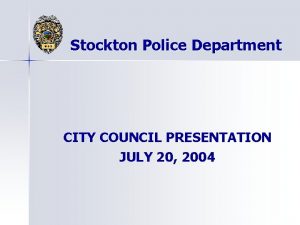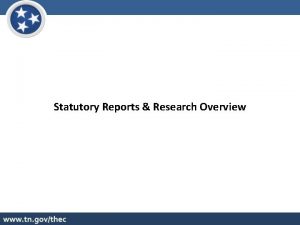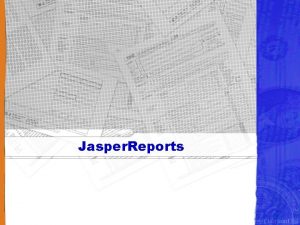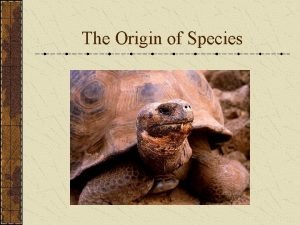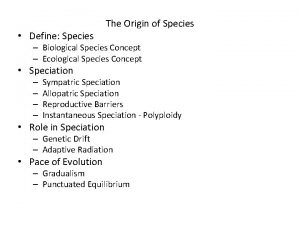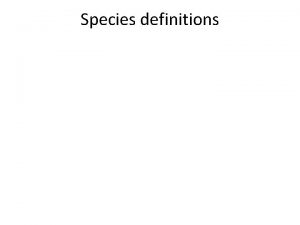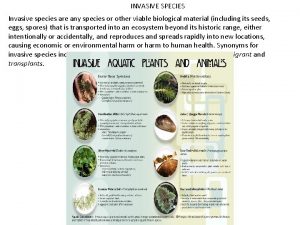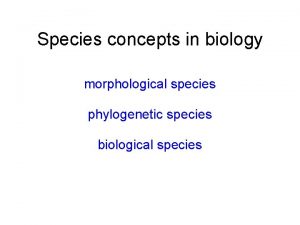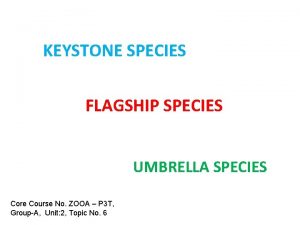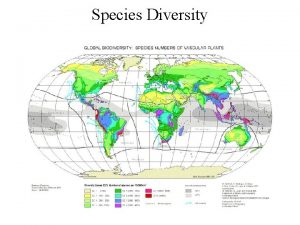Live Meeting RESULTS Reports Species Monitoring RESULTS Species





























- Slides: 29

Live Meeting RESULTS - Reports Species Monitoring

RESULTS – Species Monitoring Requirement - Concerns regarding reforested species not consistent with pre-harvest profile - Emerging requirement to closely monitor to: - Ensure achievement of young stands as per stocking standards; are we meeting only minimums versus preferred species? - Sufficient species diversity to deal with future climate change and future market conditions

RESULTS – Species Monitoring Requirement Species concerns identified through various reports: Forest Practice Board Reports • High Retention Harvesting and Timber Sustainability on the British Columbia Coast (2008) • Tree Species Harvested in Areas Affected by Mountain Pine Beetles (2007) • Species Composition and Regeneration in Cutblocks in Mountain Pine Beetle Areas (2006) State of Forest Report (2006) • Are Species before and after harvest similar?

RESULTS – Species Monitoring Challenges • Information to address monitor species reside in multiple corporate system’s “silos” • Information not easily accessible without undue effort, skills, cost and time to obtain. • Information not presented in an easily to interpret manner (trending) to assist decision-making. • Ministry lacks real time information to change actual practices

RESULTS – Species Monitoring Interim Solution • Build key Species Monitoring Reports that spans across Ministry’s “silos” • Establish the key species information in common format and location. • Provide graphical formats that enables easier interpretation. • Provide real time information to influence actual practices. • Encourage collaboration and coordination of data.

RESULTS – Species Monitoring Data for Species Monitoring Reporting Key questions are: What is the current timber profile? § Inventory Vegetation – Pending work to be completed What is being extracted? § Volume Billed – Harvest Billing System § Previous Stand Label - RESULTS What species are being planted § Planted Species – RESULTS What is the reforested stand species composition? § Forest Cover - RESULTS

RESULTS – Species Monitoring Current Tool – RESULTS Corporate Reporting System (CRS) Access CRS via RESULTS Complete Access Request form for access

RESULTS – Species Monitoring Current Tool – RESULTS Corporate Reporting System (CRS)

RESULTS – Species Monitoring Current Tool – RESULTS Corporate Reporting System (CRS)

RESULTS – Species Monitoring Current Tool – RESULTS Corporate Reporting System (CRS) All Reports have similar report filters All Reports provide. pdf & CSV (comma separated values to display and summarize different than default option); ignore other o Mandatory filter requirement – date range Enter any combination Must provide Date range Set to “Y” if require entire Management Unit Only 2 formats are available: Acrobat PDF or CSV

RESULTS – Species Monitoring Report Format - pdf Report filters

RESULTS – Species Monitoring Report format - pdf Report filters

RESULTS – Species Monitoring Report format – CSV (comma separated value) CSV importable into MSAccess, MSExcel, other tools for analysis or representation due to fixed format of CRS. pdf presentation Contains additional information that may be useful but not shown in graphs

RESULTS – Species Monitoring Report format – CSV – offers flexibility CSV Fields ROLLUP REGION CODE ORG UNIT CODE MGMT UNIT TYPE MGMT UNIT ID MGMT UNIT DESC BGC ZONE CODE BGC SUBZONE CODE QUOTA TYPE CODE BILLING YEAR DISTURBANCE START YEAR SEED SOURCE GENETIC WORTH CODE GENETIC WORTH RTNG SPECIES DESCRIPTION (Generalization) STAND TYPE (Even vs Uneven-aged) SPP VOL (Volume) SUM SPP NAR (Net Area) SUM Of PRORATE AREA (Planted & Regenerated Area) Reports Volume Previous Planting X X X X X X X X Regen X X X X Some data is not available as filter option but is available in the CSV dataset. Data is based on theme of report.

RESULTS – Species Monitoring Report format – CSV – offers flexibility Planting by Species in the CWH in Kingcome TSA YC SS PW 2000 PLC HW 1500 HM FDC 1000 DR Example of focus 0 n specific BEC Zone Planting csv extract for planting contains subzone, genetic class, genetic worth CW 500 BG BA 0 1988 1989 1990 1991 1992 1993 1994 1995 1996 1997 1998 1999 2000 2001 2002 2003 2004 2005 2006 2007 2008 Disturbance Start Year AX ACT YC AC 120% SS 100% PLC PW HW 80% HM FDC 60% DR 40% CW 20% BG 0% AX BA 1988 1989 1990 1991 1992 1993 1994 1995 1996 1997 1998 1999 2000 2001 2002 2003 2004 2005 2006 2007 2008 Proportion of Planted Area (%) Pro-rated Planted Area (ha) 2500 Disturbance Start Year ACT AC

RESULTS – Species Monitoring Report format – CSV – offers flexibility Planting in Kingcome TSA by Genetic Class for Cedar Pro-rated Planted Area (ha) 1800 1600 1400 1200 1000 800 600 400 200 0 (blank) B 19 88 19 89 19 90 19 91 19 92 19 93 19 94 19 95 19 96 19 97 19 98 19 99 20 00 20 01 20 02 20 03 20 04 20 05 20 06 20 0 20 7 08 A Example of focus 0 n Cedar & Genetic Class 120% 100% (blank) 80% B 60% A 40% 20% 0% 19 8 8 19 9 9 19 0 9 19 1 9 19 2 9 19 3 9 19 4 9 19 5 96 19 9 19 7 9 19 8 99 20 0 0 20 1 02 20 0 20 3 04 20 0 20 5 0 20 6 0 20 7 08 Proportion of Planted Area (%) Disturbance Start Year

RESULTS – Species Monitoring Usage of Reports – Strategic Focus Monitoring of harvesting of species over time through identifying shifts in the proportion of species Monitoring the shift of species planted over time – are we over-deploying certain species over certain zone, subzone and/or management unit. Monitoring the species makeup on established stands that are 7 years or older – identifying are we shifting species over time Good for broad trending, to assist in overview and monitoring… then if area of concern, then required to refer to the source data for more detailed analysis.

RESULTS – Species Monitoring Data Limitations Billing Report Billing data – only available by Timbermark (not cutblock/opening specific); therefore took the largest BEC represented by the Timbermark to enable attribution for Zone/subzone. Data range available starting as of 1995 -01 -01 to current data Previous Stand Report BEC Zone & subzone for RESULTS opening based the largest Standards Unit. Previous Stand report is only based on the leading species, where provided. There are historical records with missing previous stand label, “no species” is indicated. Data range available starting as of 1988 -01 -01 to current data

RESULTS – Species Monitoring Data Limitations Planting Report BEC zone & subzone for RESULTS opening based on the largest Standards Unit. Planted trees by species reported by number of trees planted, not by area. Planted species by area pro-rated based on trees applied to the total planted area. Recent disturbance years may have low numbers due to lag between harvest completion and reporting of planting activities. Data range available starting as of 1988 -01 -01 to current data

RESULTS – Species Monitoring Data Limitations Regenerated Forest Cover Report BEC Zone & subzone for RESULTS opening based the largest Standards Unit. Only inventory label where stocking status is immature and current age >= 7 years is considered. Even-aged & uneven-aged polygons are used, but they can be filtered in the CSV by the Stand Type field. Species distribution is based on applying the percent species reported against the silviculture polygon area. Recent disturbance year will have fewer records as it has not met threshold 7 year minimum. Data range available starting as of 1988 -01 -01 to current data

RESULTS – Species Monitoring Advantages Based on current data collected (reflects all data submitted into HBS & RESULTS) - not static onetime reports. Flexible for historical review BUT can also run for current practices to see current forestry practices/ behaviour (e. g. can run for what is being done for more recent months for HBS). Advantage – you can quickly review and monitor – CSV allows easy downloading of information into Excel to enable easy graphical displays using pivot charts. Fixed Disturbance Start Date as benchmark for comparison for RESULTS dataset. But HBS uses Billing Year as close comparison.

RESULTS – Species Monitoring Sample Reports Sample reports for full timeframe of data available for: Bulkley TSA Prince George TSA Quesnel TSA

RESULTS – Species Monitoring - Bulkley TSA

RESULTS – Species Monitoring – Quesnel TSA

RESULTS – Species Monitoring – Prince George TSA

RESULTS – Species Monitoring Usage of Reports are strategic to show general trends. Can always focus on finer detail. Points to key questions in species management: -Are we are aware of the species shifts? -Do we have the right balance of species mix (before vs. after)? - Do we have the right stocking standards that assist in controlling species at landscape level? - What can we do to prevent with some of the profile shifts?

RESULTS – Species Monitoring Moving into the Future These prototype reports to look at “mining” corporate data to deal with complex yet important strategic questions. First step is to understand what are the key strategic questions we have and whether we have the right information to report out to answer those questions. These 4 species monitoring report are 1 st attempt to mine and summarize large volumes of data. We are learning & assessing: • how difficult is it to build these? • what are the steps and whethere are critical steps involved? • determine if these sorts of reports are useful, the right format?

RESULTS – Species Monitoring Moving into the Future We learn to cooperate , collaborate and find synergies by leveraging corporate data. We need to define what are the big questions? These reports are one example of different themes. This is start of thinking what are the types of strategic reports we need. Our experience with these reports will help us when better tools are available – Business Intelligence Tool that will ultimately have better functionality, flexiblity, automation, etc. But before embarking on the right technology, we have understand what are the business questions that are the most important…. Any operational feedback on these reports & future ideas is appreciated.

RESULTS – Species Monitoring Contact information: RESULTS Lead: Caroline Mac. Leod, Caroline. Mac. Leod@gov. bc. ca RESULTS Business Support: Mei-Ching Tsoi, mtsoi@shaw. ca RESULTS main website: http: //www. for. gov. bc. ca/his/results/ Species Monitoring documentation: http: //www. for. gov. bc. ca/his/results/RESULTS_Species_Monitoring_Report_Feb 2009_v 2. pdf
 Is a report formal or informal
Is a report formal or informal Quizit live
Quizit live Live happy live healthy
Live happy live healthy Microsoft office live meeting
Microsoft office live meeting Lodi unified school district board meeting live
Lodi unified school district board meeting live Today meeting or today's meeting
Today meeting or today's meeting What is meeting and types of meeting
What is meeting and types of meeting Types of meeting
Types of meeting Today meeting or today's meeting
Today meeting or today's meeting Plant keystone species
Plant keystone species University of michigan formula sae
University of michigan formula sae Nlp radiology reports
Nlp radiology reports Quality spectrum of financial reports
Quality spectrum of financial reports Bedside shift reports what does the evidence say
Bedside shift reports what does the evidence say Long formal report
Long formal report Passive voice in news
Passive voice in news Analyzing financial performance reports
Analyzing financial performance reports Salesforce quota vs actual report
Salesforce quota vs actual report Pscb custom reports
Pscb custom reports Cdpehs
Cdpehs Most weather reports for the general public use
Most weather reports for the general public use Medidata rave symbols
Medidata rave symbols Bvp lab chd reports
Bvp lab chd reports Qqalot
Qqalot Winlink position reports
Winlink position reports The left margin for unbound reports is ____
The left margin for unbound reports is ____ Difference between formal and informal proposals
Difference between formal and informal proposals Poorly designed reports and graphs
Poorly designed reports and graphs Oncorps login
Oncorps login Stockton police reports
Stockton police reports



